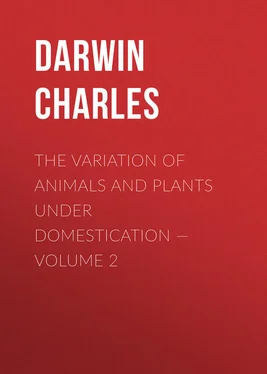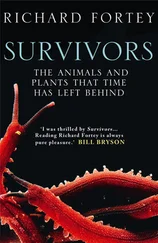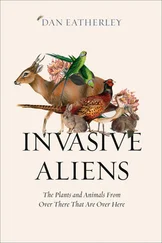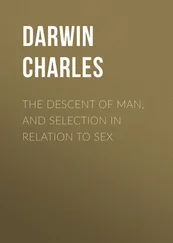Charles Darwin - The Variation of Animals and Plants under Domestication — Volume 2
Здесь есть возможность читать онлайн «Charles Darwin - The Variation of Animals and Plants under Domestication — Volume 2» — ознакомительный отрывок электронной книги совершенно бесплатно, а после прочтения отрывка купить полную версию. В некоторых случаях можно слушать аудио, скачать через торрент в формате fb2 и присутствует краткое содержание. Жанр: foreign_antique, foreign_prose, на английском языке. Описание произведения, (предисловие) а так же отзывы посетителей доступны на портале библиотеки ЛибКат.
- Название:The Variation of Animals and Plants under Domestication — Volume 2
- Автор:
- Жанр:
- Год:неизвестен
- ISBN:нет данных
- Рейтинг книги:3 / 5. Голосов: 1
-
Избранное:Добавить в избранное
- Отзывы:
-
Ваша оценка:
- 60
- 1
- 2
- 3
- 4
- 5
The Variation of Animals and Plants under Domestication — Volume 2: краткое содержание, описание и аннотация
Предлагаем к чтению аннотацию, описание, краткое содержание или предисловие (зависит от того, что написал сам автор книги «The Variation of Animals and Plants under Domestication — Volume 2»). Если вы не нашли необходимую информацию о книге — напишите в комментариях, мы постараемся отыскать её.
The Variation of Animals and Plants under Domestication — Volume 2 — читать онлайн ознакомительный отрывок
Ниже представлен текст книги, разбитый по страницам. Система сохранения места последней прочитанной страницы, позволяет с удобством читать онлайн бесплатно книгу «The Variation of Animals and Plants under Domestication — Volume 2», без необходимости каждый раз заново искать на чём Вы остановились. Поставьте закладку, и сможете в любой момент перейти на страницу, на которой закончили чтение.
Интервал:
Закладка:
At whatever period of life a new character first appears, it generally remains latent in the offspring until a corresponding age is attained, and then is developed. When this rule fails, the child generally exhibits the character at an earlier period than the parent. On this principle of inheritance at corresponding periods, we can understand how it is that most animals display from the germ to maturity such a marvellous succession of characters.
Finally, though much remains obscure with respect to Inheritance, we may look at the following laws as fairly well established.
FIRSTLY, a tendency in every character, new and old, to be transmitted by seminal and bud generation, though often counteracted by various known and unknown causes.
SECONDLY, reversion or atavism, which depends on transmission and development being distinct powers: it acts in various degrees and manners through both seminal and bud generation.
THIRDLY, prepotency of transmission, which may be confined to one sex, or be common to both sexes.
FOURTHLY, transmission, as limited by sex, generally to the same sex in which the inherited character first appeared; and this in many, probably most cases, depends on the new character having first appeared at a rather late period of life.
FIFTHLY, inheritance at corresponding periods of life, with some tendency to the earlier development of the inherited character.
In these laws of Inheritance, as displayed under domestication, we see an ample provision for the production, through variability and natural selection, of new specific forms.
CHAPTER 2.XV
ON CROSSING.
FREE INTERCROSSING OBLITERATES THE DIFFERENCES BETWEEN ALLIED BREEDS. WHEN THE NUMBERS OF TWO COMMINGLING BREEDS ARE UNEQUAL, ONE ABSORBS THE OTHER. THE RATE OF ABSORPTION DETERMINED BY PREPOTENCY OF TRANSMISSION, BY THE CONDITIONS OF LIFE, AND BY NATURAL SELECTION. ALL ORGANIC BEINGS OCCASIONALLY INTERCROSS; APPARENT EXCEPTIONS. ON CERTAIN CHARACTERS INCAPABLE OF FUSION; CHIEFLY OR EXCLUSIVELY THOSE WHICH HAVE SUDDENLY APPEARED IN THE INDIVIDUAL. ON THE MODIFICATION OF OLD RACES, AND THE FORMATION OF NEW RACES BY CROSSING. SOME CROSSED RACES HAVE BRED TRUE FROM THEIR FIRST PRODUCTION. ON THE CROSSING OF DISTINCT SPECIES IN RELATION TO THE FORMATION OF DOMESTIC RACES.
In the two previous chapters, when discussing reversion and prepotency, I was necessarily led to give many facts on crossing. In the present chapter I shall consider the part which crossing plays in two opposed directions, — firstly, in obliterating characters, and consequently in preventing the formation of new races; and secondly, in the modification of old races, or in the formation of new and intermediate races, by a combination of characters. I shall also show that certain characters are incapable of fusion.
The effects of free or uncontrolled breeding between the members of the same variety or of closely allied varieties are important; but are so obvious that they need not be discussed at much length. It is free intercrossing which chiefly gives uniformity, both under nature and under domestication, to the individuals of the same species or variety, when they live mingled together and are not exposed to any cause inducing excessive variability. The prevention of free crossing, and the intentional matching of individual animals, are the corner-stones of the breeder's art. No man in his senses would expect to improve or modify a breed in any particular manner, or keep an old breed true and distinct, unless he separated his animals. The killing of inferior animals in each generation comes to the same thing as their separation. In savage and semi-civilised countries, where the inhabitants have not the means of separating their animals, more than a single breed of the same species rarely or never exists. In former times, even in the United States, there were no distinct races of sheep, for all had been mingled together. (15/1. 'Communications to the Board of Agriculture' volume 1 page 367.) The celebrated agriculturist Marshall (15/2. 'Review of Reports, North of England' 1808 page 200.) remarks that "sheep that are kept within fences, as well as shepherded flocks in open countries, have generally a similarity, if not a uniformity, of character in the individuals of each flock;" for they breed freely together, and are prevented from crossing with other kinds; whereas in the unenclosed parts of England the unshepherded sheep, even of the same flock, are far from true or uniform, owing to various breeds having mingled and crossed. We have seen that the half-wild cattle in each of the several British parks are nearly uniform in character; but in the different parks, from not having mingled and crossed during many generations, they differ to a certain small extent.
We cannot doubt that the extraordinary number of varieties and sub-varieties of the pigeon, amounting to at least one hundred and fifty, is partly due to their remaining, differently from other domesticated birds, paired for life once matched. On the other hand, breeds of cats imported into this country soon disappear, for their nocturnal and rambling habits render it hardly possible to prevent free crossing. Rengger (15/3. 'Saugethiere von Paraguay' 1830 s. 212.) gives an interesting case with respect to the cat in Paraguay: in all the distant parts of the kingdom it has assumed, apparently from the effects of the climate, a peculiar character, but near the capital this change has been prevented, owing, as he asserts, to the native animal frequently crossing with cats imported from Europe. In all cases like the foregoing, the effects of an occasional cross will be augmented by the increased vigour and fertility of the crossed offspring, of which fact evidence will hereafter be given; for this will lead to the mongrels increasing more rapidly than the pure parent-breeds.
When distinct breeds are allowed to cross freely, the result will be a heterogeneous body; for instance, the dogs in Paraguay are far from uniform, and can no longer be affiliated to their parent-races. (15/4. Rengger 'Saugethiere' etc. s. 154.) The character which a crossed body of animals will ultimately assume must depend on several contingencies, — namely, on the relative members of the individuals belonging to the two or more races which are allowed to mingle; on the prepotency of one race over the other in the transmission of character; and on the conditions of life to which they are exposed. When two commingled breeds exist at first in nearly equal numbers, the whole will sooner or later become intimately blended, but not so soon, both breeds being equally favoured in all respects, as might have been expected. The following calculation (15/5. White 'Regular Gradation in Man' page 146.) shows that this is the case: if a colony with an equal number of black and white men were founded, and we assume that they marry indiscriminately, are equally prolific, and that one in thirty annually dies and is born; then "in 65 years the number of blacks, whites, and mulattoes would be equal. In 91 years the whites would be 1-10th, the blacks 1-10th, and the mulattoes, or people of intermediate degrees of colour, 8-10ths of the whole number. In three centuries not 1-100th part of the whites would exist."
When one of two mingled races exceed the other greatly in number, the latter will soon be wholly, or almost wholly, absorbed and lost. (15/6. Dr. W.F. Edwards in his 'Caracteres Physiolog. des Races Humaines' page 24 first called attention to this subject, and ably discussed it.) Thus European pigs and dogs have been largely introduced in the islands of the Pacific Ocean, and the native races have been absorbed and lost in the course of about fifty or sixty years (15/7. Rev. D. Tyerman and Bennett 'Journal of Voyages' 1821-1829 volume 1 page 300.); but the imported races no doubt were favoured. Rats may be considered as semi-domesticated animals. Some snake-rats (Mus alexandrinus) escaped in the Zoological Gardens of London "and for a long time afterwards the keepers frequently caught cross-bred rats, at first half-breds, afterwards with less of the character of the snake-rat, till at length all traces of it disappeared." (15/8. Mr. S.J. Salter 'Journal Linn. Soc.' volume 6 1862 page 71.) On the other hand, in some parts of London, especially near the docks, where fresh rats are frequently imported, an endless variety of intermediate forms may be found between the brown, black, and snake rat, which are all three usually ranked as distinct species.
Читать дальшеИнтервал:
Закладка:
Похожие книги на «The Variation of Animals and Plants under Domestication — Volume 2»
Представляем Вашему вниманию похожие книги на «The Variation of Animals and Plants under Domestication — Volume 2» списком для выбора. Мы отобрали схожую по названию и смыслу литературу в надежде предоставить читателям больше вариантов отыскать новые, интересные, ещё непрочитанные произведения.
Обсуждение, отзывы о книге «The Variation of Animals and Plants under Domestication — Volume 2» и просто собственные мнения читателей. Оставьте ваши комментарии, напишите, что Вы думаете о произведении, его смысле или главных героях. Укажите что конкретно понравилось, а что нет, и почему Вы так считаете.












